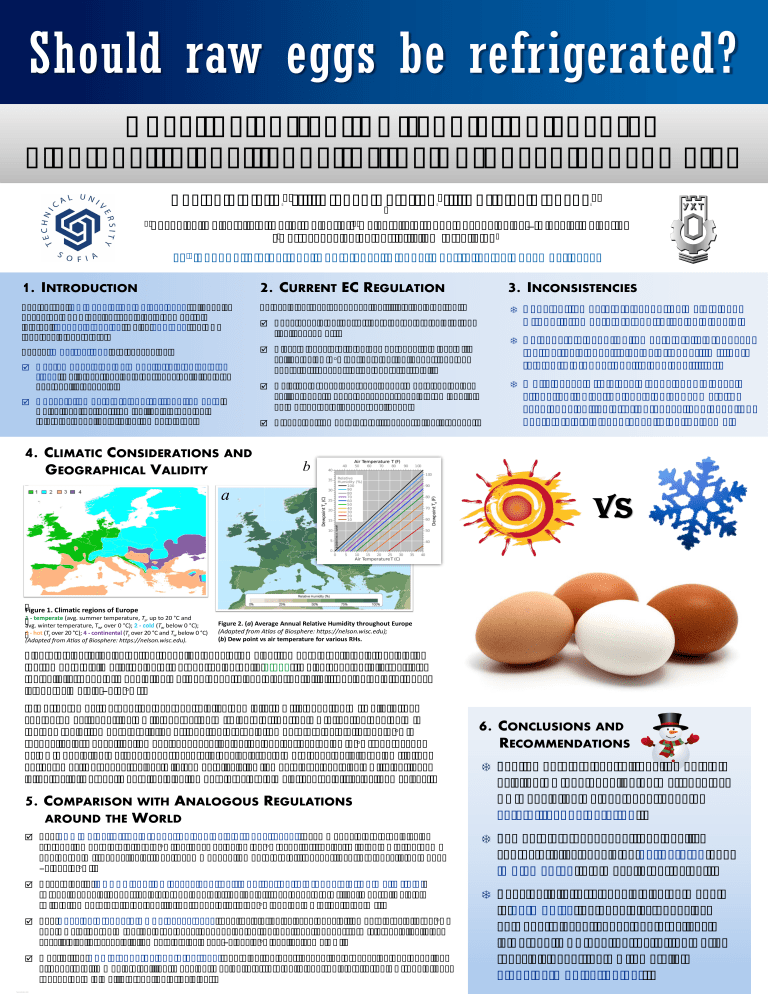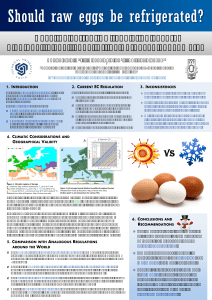
Should raw eggs be refrigerated? Does the current EU regulation ensure high-quality shell eggs for the European consumers? Kostadin Fikiin a * a Technical Stepan Akterian b Borislav Stankov a University of Sofia, Bulgaria; b University of Food Technologies ‒ Plovdiv, Bulgaria * Corresponding author: k.fikiin@tu-sofia.bg 30th EFFoST International Conference, Vienna, Austria, 28-30 November 2016 1. INTRODUCTION 2. CURRENT EC REGULATION 3. INCONSISTENCIES The current EC Regulation No 589/2008 (allegedly based on EFSA advice) contains a number of internal inconsistencies, which confuse the EU food chain operators. To avoid surface condensation, it is stipulated that: Constant temperature cannot be maintained without a temperature-controlled cold chain. These imperfections are caused by: Class A eggs are to be downgraded to Class B if chilled below 5 C during a period longer than 24 hours for transport or 72 hours for retail; Overemphasis on Salmonella-related safety risks, while overlooking other substantial safety and quality aspects; Obscure temperature control requirements, which inspires fear from chilled storage but tolerates handling at high temperatures. 4. CLIMATIC CONSIDERATIONS AND GEOGRAPHICAL VALIDITY Eggs should not be refrigerated before sale to the final consumer; Only the French overseas departments can enjoy chilled eggs, whose packages should prominently be marked as a 'dangerous' good; A constant temperature of transportation is sought. No concrete handling temperature is proposed (neither as a specific value or upper limit, nor related to product quality and shelf life). While packs with class A eggs should have a labelled indication advising consumers to keep eggs chilled after purchase, egg handling operators are discouraged to do the same. b a vs Figure 1. Climatic regions of Europe 1 - temperate (avg. summer temperature, Ts, up to 20 °C and avg. winter temperature, Tw, over 0 °C); 2 - cold (Tw below 0 °C); 3 - hot (Ts over 20 °C); 4 - continental (Ts over 20 °C and Tw below 0 °C) (Adapted from Atlas of Biosphere: https://nelson.wisc.edu). Figure 2. (a) Average Annual Relative Humidity throughout Europe (Adapted from Atlas of Biosphere: https://nelson.wisc.edu); (b) Dew point vs air temperature for various RHs. Figure 1 clearly indicates that handling eggs at ambient temperatures is only feasible in the temperate climatic region of Europe (coloured in green), which substantially restricts the validity range of Regulation No. 589/2008 (given also the initial freezing point of eggs is approximately −2.2 C). In Northernmost Europe the average relative humidity, RH, is about 90 %, while in the southernmost countries RH is approx. 60 % (Figure 2). For an RH of 90, 70 and 60 %, the dew-point temperature is lower than the dry-bulb temperature by 1.5, 5 and 7 C, respectively. Hence, the famous condensation on the egg surface below 5 C (addressed by EU Regulation No. 589/2008) occurs intensively, as a more substantial problem, in the northernmost European regions with comparatively low temperatures and high RH, rather than in the rest of Europe, where the high temperatures are a major source of risk by themselves. 5. COMPARISON WITH ANALOGOUS REGULATIONS AROUND THE WORLD The FAO Guide for the Production and Sale of Eggs (2003) recommends a preferable cold storage temperature of 0-1.5 C, but anyway below 13 C even for tropics (with an RH of 80-85% and 75-80 %, respectively). The recommended temperature of transport over 5-6 days is between −1 and 1 C. According to 'HACCP and ISO 22000 and their Application to Products of Animal Origin' (Arvanitoyannis, 2009), cold storage and distribution of fresh eggs are Critical Control Points (with a temperature to be kept in the range of 8 to 22 C and an RH of 60 to 75 %). The Russian Standard GOST 31654-2012 requires storing chicken eggs at temperatures of 0-20 C and RHs of 85-88 % during 7-25 days, depending on the egg type. Longer-term storage of up to 90 days is also foreseen at a temperature between −2 and 0 C and the same RH. Most of the USA standards and practices regarding the post-incubation processing and handling of eggs (e.g. immediate chilling, washing, waxing, etc.) are quite contradictory to the EU regulations (based on minimal intervention principles). View publication stats 6. CONCLUSIONS AND RECOMMENDATIONS The temperature control requirements of existing EU egg handling norms (such as EC Regulation No 589/2008) need a careful reconsideration. Temperature-dependent food quality characteristics should be deliberated and implemented to a much larger extent. Substantial efforts should also be made to harmonize the huge discrepancies between relevant codes and practices in Europe, USA and the rest of the world (possibly under the GHI umbrella: globalharmonization.net).

